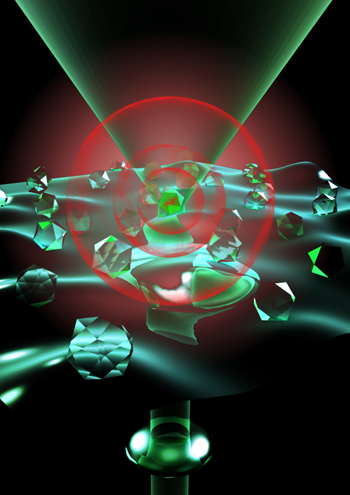Tiny diamond sparklers may hold the key to big advances in biomedical imaging technology
Post Date: 06 Aug 2011 Viewed: 553
The discovery may pave the way for the future development of more accurate bioimaging techniques used to diagnose and track complex biological processes.
The research, undertaken by a team which included scientists from Macquarie, the ANU, CSIRO and the University of Queensland, was published in the prestigious international journal, Nature Nanotechnology, today.
For the first time, the scientists were able to visualise a single blinking light signal being emitted from a single isolated nano-diamond, Rabeau said.
“We found that the properties of the light in these nano-diamonds are significantly different from larger diamonds and this is an important scientific clue about how the light is changed depending on the size of the crystal,” he said.
“In larger diamonds, the light emission or fluorescence is well known to remain steady, essentially immune to blinking on and off. But we found that when the atoms are trapped in nano-diamonds which are much smaller, they start to behave a bit differently.”
Rabeau and his team also demonstrated that the irregular fluorescence behaviour could be reversed by encapsulating the diamonds in a polymer sheath.
Rabeau said this is a big step in developing existing ideas on using nano-diamonds for bioimaging, and may indeed herald new technologies which exploit the use of the blinking optical feature. When attached to a biological molecule, like a protein, a light emitting from a nano-diamond may allow scientists to more accurately track where it travels in the body.
Proteins by themselves are essentially invisible, but by attaching bright probes like nano-diamonds, it is possible to see where they are and where they are travelling to. Existing techniques employ other types of ‘fluorescent probes’ in biomedical imaging, but they can often extinguish or turn dark and may be toxic in a live body, Rabeau said.
The tiny synthetically-produced diamonds are around five nanometers in size and more than a thousand times smaller than the width of a human hair. Rabeau and his team, along with numerous other groups around the world, believe that nano-diamonds have the potential to be used effectively in a biological environment as low toxicity and stable luminescent probes. Producing these diamonds, which are fluorescent and now small enough to not interfere with biological processes, is a big step toward practical biomedical imaging using nano-diamonds.




